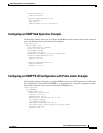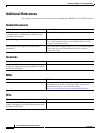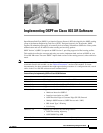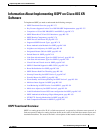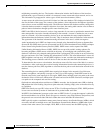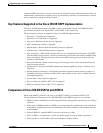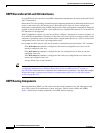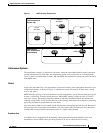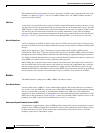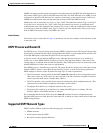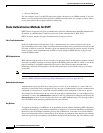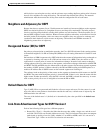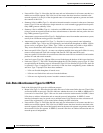
Implementing OSPF on Cisco IOS XR Software
Information About Implementing OSPF on Cisco IOS XR Software
RC-175
Cisco IOS XR Routing Configuration Guide
OL-14356-01
minimum, OSPF-based routers or access servers can be configured with all default parameter values, no
authentication, and interfaces assigned to areas. If you intend to customize your environment, you must
ensure coordinated configurations of all routers.
Key Features Supported in the Cisco IOS XR OSPF Implementation
The Cisco IOS XR implementation of OSPF conforms to the OSPF Version 2 and OSPF Version 3
specifications detailed in the Internet RFC 2328 and RFC 2740, respectively.
The following key features are supported in the Cisco IOS XR implementation:
• Hierarchy—CLI hierarchy is supported.
• Inheritance—CLI inheritance is supported.
• Stub areas—Definition of stub areas is supported.
• NSF—Nonstop forwarding is supported.
• SPF throttling—Shortest path first throttling feature is supported.
• LSA throttling—LSA throttling feature is supported.
• Fast convergence—SPF and LSA throttle timers are set, configuring fast convergence. The OSPF
LSA throttling feature provides a dynamic mechanism to slow down LSA updates in OSPF during
network instability. LSA throttling also allows faster OSPF convergence by providing LSA rate
limiting in milliseconds.
• Route redistribution—Routes learned using any IP routing protocol can be redistributed into any
other IP routing protocol.
• Authentication—Plain text and MD5 authentication among neighboring routers within an area is
supported.
• Routing interface parameters—Configurable parameters supported include interface output cost,
retransmission interval, interface transmit delay, router priority, router “dead” and hello intervals,
and authentication key.
• Virtual links—Virtual links are supported.
• Not-so-stubby area (NSSA)—RFC 1587 is supported.
• OSPF over demand circuit—RFC 1793 is supported.
Comparison of Cisco IOS XR OSPFv3 and OSPFv2
Much of the OSPFv3 protocol is the same as in OSPFv2. OSPFv3 is described in RFC 2740.
The key differences between the Cisco IOS XR OSPFv3 and OSPFv2 protocols are as follows:
• OSPFv3 expands on OSPFv2 to provide support for IPv6 routing prefixes and the larger size of IPv6
addresses.
• When using an NBMA interface in OSPFv3, users must manually configure the router with the list
of neighbors. Neighboring routers are identified by the link local address of the attached interface
of the neighbor.
• Unlike in OSPFv2, multiple OSPFv3 processes can be run on a link.
• LSAs in OSPFv3 are expressed as “prefix and prefix length” instead of “address and mask.”
• The router ID is a 32-bit number with no relationship to an IPv6 address.



